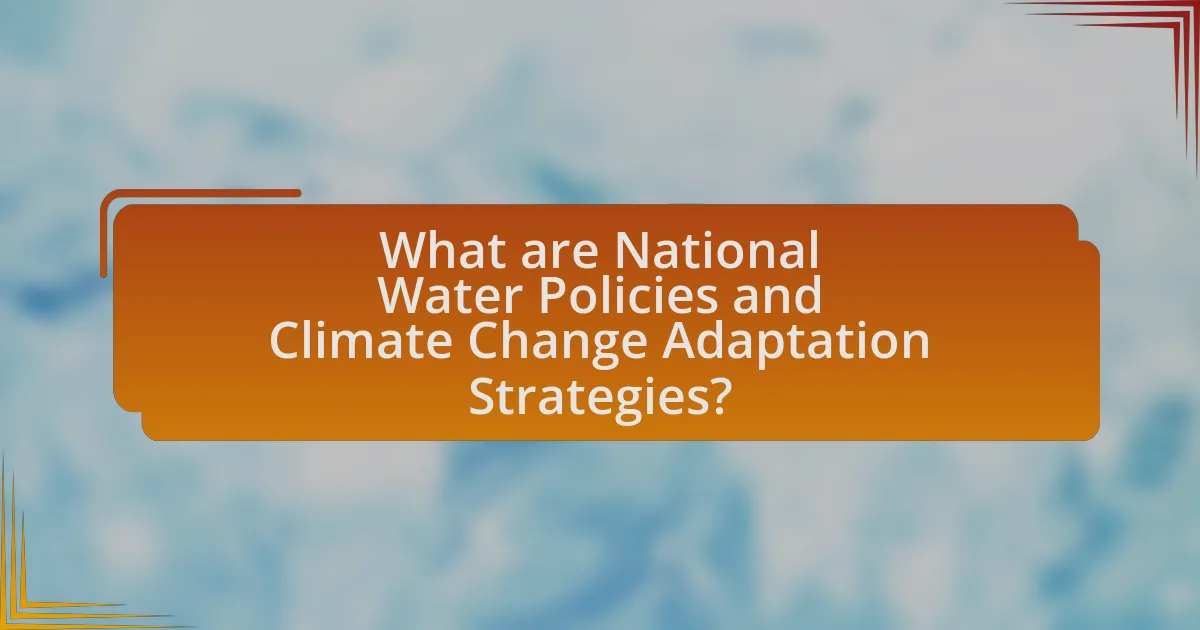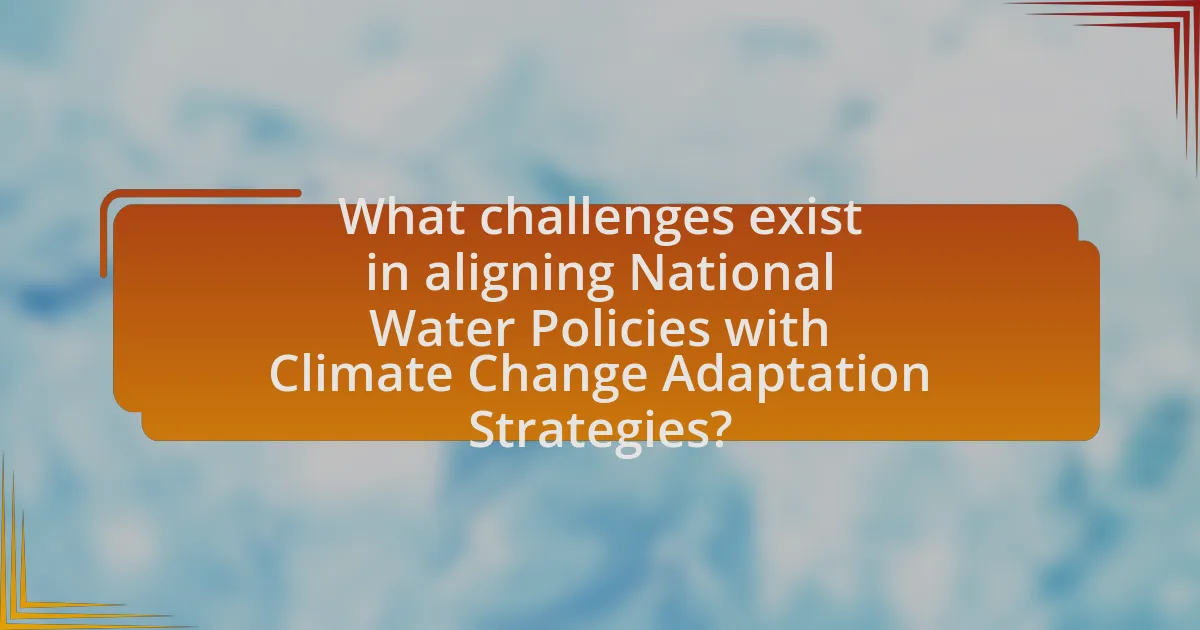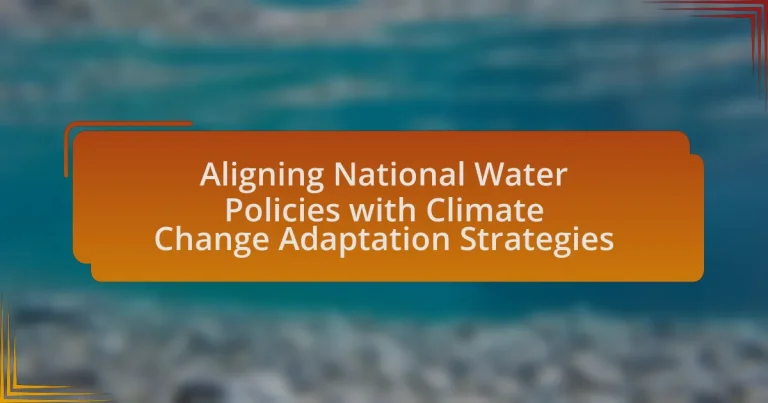National Water Policies are essential frameworks established by governments to manage water resources sustainably, while Climate Change Adaptation Strategies encompass actions aimed at mitigating the impacts of climate change on these resources. This article examines the integration of these two critical areas, highlighting how effective national water policies can enhance climate resilience through strategies such as improved infrastructure, stakeholder engagement, and adaptive management practices. It discusses the importance of aligning these policies to ensure sustainable water management, the challenges faced in achieving this alignment, and the role of data, research, and international frameworks in guiding effective policy integration. Additionally, it outlines practical steps for policymakers to initiate alignment efforts and the benefits of adopting global best practices in water management.
What are National Water Policies and Climate Change Adaptation Strategies?

National Water Policies are frameworks established by governments to manage water resources sustainably, ensuring equitable access, quality, and conservation. Climate Change Adaptation Strategies are actions and plans designed to mitigate the impacts of climate change on water resources, such as increased flooding or droughts. These strategies often include measures like improving water infrastructure, enhancing water efficiency, and protecting watersheds. The integration of National Water Policies with Climate Change Adaptation Strategies is essential for resilience, as evidenced by the United Nations’ Sustainable Development Goal 6, which emphasizes the importance of water management in the context of climate change.
How do National Water Policies address climate change?
National Water Policies address climate change by integrating climate resilience into water management frameworks. These policies often include strategies for sustainable water use, protection of water resources, and adaptation measures to mitigate the impacts of climate variability. For instance, many countries have adopted measures such as improving water infrastructure, promoting efficient irrigation practices, and enhancing watershed management to cope with changing precipitation patterns and increased flooding or drought events. Evidence of this can be seen in the United Nations Framework Convention on Climate Change, which emphasizes the importance of water management in climate adaptation strategies, highlighting that effective water governance is crucial for reducing vulnerability to climate impacts.
What are the key components of effective National Water Policies?
Effective National Water Policies include integrated water resource management, stakeholder engagement, regulatory frameworks, and climate resilience strategies. Integrated water resource management ensures that water resources are managed holistically, considering the interconnections between water, land, and ecosystems. Stakeholder engagement involves the participation of communities, governments, and private sectors in decision-making processes, which enhances transparency and accountability. Regulatory frameworks establish clear guidelines and standards for water use and protection, ensuring sustainable practices. Climate resilience strategies incorporate adaptive measures to address the impacts of climate change on water resources, such as droughts and floods, thereby safeguarding water availability and quality. These components collectively contribute to the effectiveness of national water policies in the context of climate change adaptation.
How do these components interact with climate change adaptation?
The components of national water policies and climate change adaptation strategies interact by ensuring that water management practices are resilient to climate impacts. Effective water policies incorporate adaptive measures that address changing precipitation patterns, increased flooding, and drought conditions, which are direct consequences of climate change. For instance, the integration of climate data into water resource planning allows for more informed decision-making, enhancing the ability to manage water supply and quality under varying climate scenarios. This interaction is supported by evidence from the Intergovernmental Panel on Climate Change, which emphasizes the importance of adaptive water governance in mitigating climate risks and promoting sustainable water use.
Why is aligning these policies important?
Aligning national water policies with climate change adaptation strategies is important because it ensures sustainable water management in the face of climate variability. Effective alignment allows for the integration of climate risks into water resource planning, which is crucial for maintaining water availability and quality. For instance, the Intergovernmental Panel on Climate Change (IPCC) emphasizes that uncoordinated policies can lead to increased vulnerability of water systems, exacerbating issues like droughts and floods. By aligning these policies, countries can enhance resilience, optimize resource allocation, and improve overall governance, ultimately safeguarding water resources for future generations.
What are the potential impacts of misalignment?
The potential impacts of misalignment between national water policies and climate change adaptation strategies include increased vulnerability to water scarcity, heightened flood risks, and compromised ecosystem health. Misalignment can lead to inefficient resource allocation, where water management practices do not address the changing climate conditions, resulting in inadequate responses to droughts or floods. For instance, a study by the World Bank highlights that countries lacking integrated water management face significant economic losses, estimated at up to 6% of GDP, due to climate-related water challenges. This underscores the critical need for alignment to ensure sustainable water management and resilience against climate impacts.
How can alignment enhance water security?
Alignment can enhance water security by ensuring that national water policies are integrated with climate change adaptation strategies. This integration allows for a coordinated approach to managing water resources, which is crucial in addressing the impacts of climate variability, such as droughts and floods. For instance, countries that align their water management frameworks with climate resilience measures can better allocate resources, implement sustainable practices, and protect water quality. Evidence from the United Nations Framework Convention on Climate Change indicates that countries with aligned policies experience improved water governance and increased resilience to climate-related risks, ultimately leading to enhanced water security.
What challenges exist in aligning National Water Policies with Climate Change Adaptation Strategies?

Aligning National Water Policies with Climate Change Adaptation Strategies faces several challenges, including institutional fragmentation, lack of data, and competing priorities. Institutional fragmentation occurs when multiple agencies manage water resources without coordinated efforts, leading to inefficiencies and conflicting policies. The lack of reliable data on water availability and climate impacts hampers effective planning and decision-making. Additionally, competing priorities among stakeholders, such as economic development versus environmental protection, complicate the integration of climate adaptation into water policies. These challenges hinder the development of cohesive strategies that effectively address both water management and climate resilience.
What are the common barriers to effective alignment?
Common barriers to effective alignment in national water policies and climate change adaptation strategies include lack of coordination among stakeholders, insufficient data and information sharing, and conflicting policy objectives. Lack of coordination often results in fragmented approaches, where different agencies or sectors pursue their own goals without considering the broader implications for water management and climate resilience. Insufficient data hampers decision-making, as policymakers may not have access to the necessary information to assess risks and develop effective strategies. Conflicting policy objectives can lead to situations where water management goals undermine climate adaptation efforts, creating a cycle of inefficiency and ineffectiveness in addressing both water security and climate resilience.
How do institutional frameworks affect policy alignment?
Institutional frameworks significantly influence policy alignment by establishing the rules, norms, and structures that guide decision-making processes. These frameworks create a cohesive environment where policies can be developed and implemented in a manner that is consistent with overarching goals, such as climate change adaptation. For instance, effective institutional frameworks facilitate collaboration among various stakeholders, ensuring that national water policies are integrated with climate strategies. Research indicates that countries with strong institutional frameworks, such as those outlined in the OECD’s “Water Governance in the OECD” report, demonstrate better alignment of water policies with climate objectives, leading to more resilient and adaptive management practices.
What role does funding play in overcoming these barriers?
Funding plays a crucial role in overcoming barriers to aligning national water policies with climate change adaptation strategies. Adequate financial resources enable governments and organizations to implement necessary infrastructure improvements, conduct research, and develop innovative technologies that address water scarcity and quality issues exacerbated by climate change. For instance, a study by the Global Water Partnership highlights that investments in water management systems can enhance resilience to climate impacts, demonstrating that funding directly correlates with improved adaptive capacity in water policies.
How can stakeholder engagement improve alignment?
Stakeholder engagement can improve alignment by fostering collaboration and ensuring that diverse perspectives are integrated into decision-making processes. When stakeholders, including government agencies, local communities, and environmental organizations, actively participate, they contribute valuable insights that help identify common goals and priorities. This collaborative approach leads to more coherent and effective national water policies that are better aligned with climate change adaptation strategies. Research indicates that inclusive stakeholder engagement enhances policy effectiveness by increasing buy-in and reducing conflicts, ultimately resulting in more sustainable outcomes.
What strategies can be employed to involve local communities?
To involve local communities in aligning national water policies with climate change adaptation strategies, participatory approaches should be employed. These approaches include engaging community members in decision-making processes, conducting workshops to gather local knowledge, and forming partnerships with local organizations. Evidence from the United Nations Development Programme indicates that community involvement leads to more effective and sustainable water management practices, as local insights can enhance policy relevance and implementation success.
How can collaboration between sectors enhance policy effectiveness?
Collaboration between sectors enhances policy effectiveness by integrating diverse expertise and resources, leading to more comprehensive and adaptable solutions. For instance, when environmental agencies work alongside agricultural and urban planning sectors, they can create water policies that address both climate change impacts and local water needs. This multi-sectoral approach has been shown to improve resource allocation and stakeholder engagement, as evidenced by the success of integrated water resource management frameworks in countries like Australia, where collaboration has led to significant improvements in water conservation and quality.
What best practices can be adopted for effective alignment?

Effective alignment of national water policies with climate change adaptation strategies can be achieved through integrated planning and stakeholder engagement. Integrated planning ensures that water management considers climate impacts, while stakeholder engagement fosters collaboration among government agencies, local communities, and experts. Research indicates that countries employing integrated approaches, such as the Netherlands, have successfully adapted their water policies to address climate variability, demonstrating the effectiveness of these practices.
How can data and research inform policy alignment?
Data and research can inform policy alignment by providing evidence-based insights that guide decision-making processes. For instance, comprehensive data analysis on water resource availability and climate projections enables policymakers to identify vulnerabilities and prioritize adaptation strategies. Research findings, such as those from the Intergovernmental Panel on Climate Change, highlight the need for integrated water management approaches that consider climate impacts, thereby aligning national water policies with climate change adaptation efforts. This alignment is further supported by case studies demonstrating successful implementation of data-driven policies that enhance resilience to climate variability.
What types of data are most useful for decision-making?
Quantitative data, qualitative data, and predictive analytics are the most useful types of data for decision-making. Quantitative data provides measurable and numerical insights, allowing for statistical analysis and objective evaluation of trends, such as water usage statistics and climate data. Qualitative data offers contextual understanding through interviews and surveys, capturing stakeholder perspectives on water policies and climate impacts. Predictive analytics utilizes historical data to forecast future scenarios, aiding in proactive decision-making regarding resource allocation and policy adjustments. These data types collectively enhance the ability to make informed, evidence-based decisions in the context of aligning national water policies with climate change adaptation strategies.
How can research findings be integrated into policy frameworks?
Research findings can be integrated into policy frameworks by establishing collaborative mechanisms between researchers and policymakers. This integration can be achieved through structured dialogues, workshops, and advisory committees that facilitate the exchange of knowledge and ensure that scientific evidence informs decision-making processes. For instance, the Intergovernmental Panel on Climate Change (IPCC) provides comprehensive assessments that guide national policies on climate adaptation, demonstrating how empirical research can shape effective policy frameworks.
What role do international frameworks play in guiding alignment?
International frameworks play a crucial role in guiding alignment by establishing common standards and best practices for countries to follow in addressing climate change impacts on water policies. These frameworks, such as the Paris Agreement and the United Nations Sustainable Development Goals, provide a structured approach for nations to integrate climate adaptation strategies into their water management systems. For instance, the Paris Agreement encourages countries to develop nationally determined contributions (NDCs) that reflect their commitments to climate resilience, thereby influencing national water policies to align with global climate objectives. This alignment is essential for ensuring that water resources are managed sustainably in the face of climate change, as evidenced by the increasing recognition of integrated water resources management (IWRM) principles in international discussions.
How can countries learn from each other’s experiences?
Countries can learn from each other’s experiences by sharing best practices and lessons learned in the context of climate change adaptation strategies. For instance, nations facing similar water scarcity issues can analyze successful policies implemented elsewhere, such as integrated water resource management in the Netherlands, which has effectively addressed flooding and water quality challenges. Collaborative platforms like the United Nations Framework Convention on Climate Change facilitate knowledge exchange, allowing countries to adapt proven strategies to their unique contexts. This exchange of information is supported by data showing that countries that engage in international cooperation on water management are more likely to achieve sustainable outcomes, as evidenced by the success of transboundary water agreements in regions like the Nile Basin.
What are the benefits of adopting global best practices?
Adopting global best practices enhances the effectiveness and efficiency of national water policies in addressing climate change adaptation. These practices provide proven frameworks and methodologies that have been successful in various contexts, allowing countries to leverage existing knowledge and avoid common pitfalls. For instance, the implementation of integrated water resource management (IWRM) has been recognized by the United Nations as a key strategy for sustainable water management, leading to improved resilience against climate impacts. Furthermore, adopting these practices can facilitate international collaboration and funding opportunities, as stakeholders are more likely to invest in initiatives that align with recognized standards and benchmarks.
What practical steps can be taken to align National Water Policies with Climate Change Adaptation Strategies?
To align National Water Policies with Climate Change Adaptation Strategies, governments should integrate climate risk assessments into water management frameworks. This involves conducting comprehensive evaluations of how climate change impacts water resources, including changes in precipitation patterns and increased frequency of extreme weather events.
Additionally, establishing multi-stakeholder platforms can facilitate collaboration among government agencies, local communities, and private sectors to ensure that water policies reflect the realities of climate change. Implementing adaptive management practices, such as flexible water allocation systems that can respond to changing conditions, is also crucial.
Furthermore, investing in infrastructure that enhances water resilience, such as rainwater harvesting systems and improved drainage, supports adaptation efforts. Evidence from the United Nations Framework Convention on Climate Change indicates that integrating climate considerations into water policies can significantly enhance the effectiveness of adaptation strategies, ultimately leading to more sustainable water management practices.
What are the first steps for policymakers to initiate alignment?
Policymakers should first conduct a comprehensive assessment of existing national water policies to identify gaps and inconsistencies related to climate change adaptation. This assessment enables them to understand how current policies align with climate resilience objectives. Following this, engaging stakeholders—including local communities, environmental experts, and industry representatives—is crucial for gathering diverse perspectives and fostering collaboration. Research indicates that inclusive policymaking enhances the effectiveness of adaptation strategies, as seen in case studies from countries like Germany and Australia, where stakeholder engagement led to more robust water management frameworks.
How can ongoing monitoring and evaluation support alignment efforts?
Ongoing monitoring and evaluation can significantly support alignment efforts by providing real-time data and insights that inform decision-making processes. This continuous assessment allows stakeholders to identify gaps between current water policies and climate adaptation strategies, ensuring that both are effectively integrated. For instance, regular evaluations can reveal the effectiveness of implemented policies in addressing climate impacts, enabling timely adjustments to enhance resilience. Furthermore, studies have shown that adaptive management frameworks, which rely on ongoing monitoring, lead to improved policy coherence and better resource allocation, ultimately fostering a more sustainable approach to water management in the context of climate change.


